The Stairway to Life
An Origin-of-Life Reality Check
Change Laura Tan and Rob Stadler
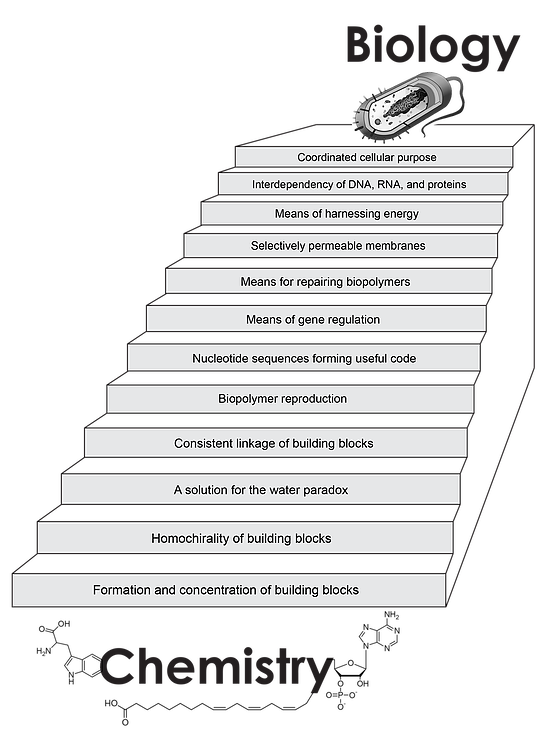
p9 Introduction
p9 "With animals, some spring from parent animals according to their kind, whilst others grow spontaneously and not from kindred stock; and of these instances of spontaneous generation some come from putrefying Earth or vegetable matter, as is the case with a number of insects, while others are spontaneously generated in the inside of animals out of the secretions of their several organs." Aristotle, The History of Animals, Book V, 4th century BC.
p9 The above is sometimes termed "Aristotelian abiogenesis" while "abiogenesis" refers to life arising naturally from nonliving matter.
p10 Support for spontaneous generation persisted for two millennia after Aristotle, but retreated to just small forms of life. A big step was made by Francesco Redi, an Italian physician and biologist:
"Although content to be corrected by anyone wiser than myself, if I should make erroneous statements, I shall express my belief that the Earth, after having brought forth the first plants and animals at the beginning by order of the Supreme and Omnipotent Creator, has never since produced any kinds of plants or animals, either perfect or imperfect; and everything which we know in past or present times that she has produced, came solely from the true seeds of the plants and animals themselves, which thus, through means of their own, preserve their species. "
Redi had resorted to experiment and observed that maggots did not arise from decaying flesh when placed in a jar covered by gauze. This may have been convincing about the maggots, but about this time Robert Hooke's microscope discovered microorganisms and the belief that these microorganisms could spontaneously generate persisted for another two hundred years or so. Example of Erasmus Darwin, grandfather of Charles and his belief in the spontaneous generation of microorganisms.
p12 In 1859 Louis Pasteur's experiments with boiled broth in swan-necked bottle indicated that not even microscopic life could arise spontaneously. This was the same year as Darwin's publication of On the Origin of Species.
p12 Quote of Darwin's "warm little pond" description of life's origin, and pointing to today's belief in "abiogenesis". A new form of spontaneous generation in the theory of evolution.
p13 "Darwin is joined by every atheist because the absence of god necessitates a naturalistic explanation for the start of life, even if it happened on some other planet."
p13-14 Surveys the promotion of abiogenesis by NASA, by Bill Nye, by those who see "questioning abiogenesis is tantamount to promoting religion", typical modern biology texts which treat abiogenesis as dogma.
p15 Michael Denton "Considering the way the prebiotic soup is referred to in so many discussions of the origin of life as an already established reality, it comes as something of a shock to realize that there is absolutely no positive evidence for its existence." from "Evolution, a Theory in Crisis", p261.
p15 Begins the discussion of Craig Venter's quest to build a self-replicating species, the culmination of which was announced in 2010 after 15 years of work. Single-celled organism Mycoplasma mycoides, better known as Synthia.
p16-17 Describes some of the reactions to the production of Synthia. Sets up the author's review of Venter's work. Sets up the authors' investigation of the fundamental requirements for life in the structure "the Stairway to Life".
p17 "The Stairway to Life provides a new perspective on abiogenesis because each of the twelve required steps is profoundly unlikely to occur in a prebiotic world, and the improbabilities of each step must be multiplied to arrive at the infinitesimal overall likelihood of abiogenesis."
p19 Part I. Lessons from Synthetic Life
p21 Ch 1: Recipe for a Self-Replicating Cell
p31 Ch 2: Synthesis of the Synthia Genome
p45 Ch 3: Decoding the Code
p51 Ch 4: So Close, Yet So Far Away
p57 Ch 5: The Culmination of Fifteen Years of Work
p61 Part II. The Overlooked Reality of Life's Complexity
p63 Ch 6: The Stairway to Life
p63 Quotes Haeckel's oversimplification of the nature of living cells.
p64 "Countless biology textbooks describe the Miller-Urey experiment .. as strong evidence that life began spontaneously. This argument seemingly equates the simplicity of a bagful of amino acids (formed by a natural process) with the unimaginable complexity of living organisms."
p64-66 Continues with several similar examples where the complexity of life seems to be ignored. Wraps that section with "The fantastic complexity of all known life-forms stands in stark contrast to what our schools are teaching, what some scientists believe, and what popular media suggests."
p68 Sets up the staircase and describes the process - although each step is highly improbable in an abiotic setting, it will be presumed to have been overcome when the next step is approached.
p68-70 Lays out 6 criteria for a scientific study worth of high confidence:
- Repeatability: The origin of life is the antithesis of repeatability
- Direct and accurate measurement: trace remnants of evidence, extremely indirect
- Prospective, interventional study: inapplicable to an event from four billion years ago.
- Assumptions minimized: assumptions only way to fill vast unknowns
- Bias avoided: bias rampant because of minimal hard evidence and dogmatic, bipartisan beliefs
- Results summarized with sober judgment: confidence and clarity unachievable, popular opinion demonstrates the opposite!
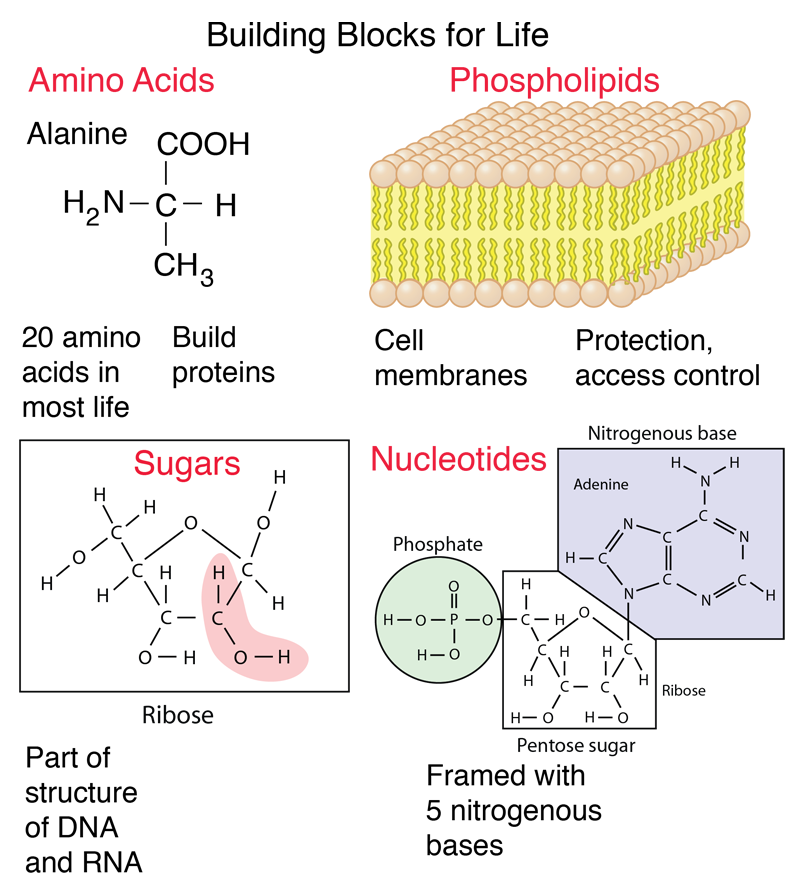
p71 Ch 7: Formation and Concentration of the Building Blocks
p71 Fundamental set of building materials: amino acids, sugars, nitrogenous bases, phospholipids.
p71 Thousands of published papers, structure A+B produces C under conditions D, E and F
p72 Orgel's requirements for abiogenesis:
- Plausible that starting materials be present
- Reactions occur in water or in absence of solvent
- Significant yield
p73-74 Amino acids. Miller in 1953, produced glycine, alpha alanine and beta alanine from H2,NH3,CH4,H2O in absence of O2, reducing atmosphere. Followed Alexander Oparin's "The Origin of Life".
p74 While many have regarded as strong evidence for abiogenesis, actually only accomplished a part of the first step out of the twelve.
p74 Jeffrey Bada, former grad student of Miller, reanalyzed samples after 50years, one with H2S gave 10 of 20 amino acids of life plus a predominance of amino acids,amines and other molecules that are not found in life.
p74 With continuous debate about nature of early atmosphere, Dustin Trail analyzed cerium in zircons to find higher oxidation state than anticipated, suggesting more oxygen in atmosphere than Miller presumed.
p75 Proposal of hydrothermal vents as abiogenesis site, Nick Lane advocates alkaline hydrothermal vents.
p76 Phospholipids. Bacteria and archaea have very different phospholipids, raising questions about common ancestry. Experiments that have produced phospholipids have not produced the kind produced in known life. "left with low confidence hints of possibilities"
p78 Nucleotides Building blocks of DNA and RNA. Nitrogenous base, pentose sugar, and phosphate molecule. But they can combine in hundreds of ways, whereas "one arrangement is found in all of life".
p79-80 Adenine ribonucleotide could be formed in 180 ways, which would mean that "the probability of linking a chain to make RNA of any reasonable length is effectively zero". And this is a simple case, not taking into account the full diversity of the "soup".
p80-81 Discusses how this scenario raises questions about the feasibility of the "RNA world".
p82 Quotes Simpson, who sees abiogenesis as "inescapable": "The consensus is that life did arise naturally from the nonliving and that even the first living things were not specially created. The conclusion has, indeed, really become inescapable, for the first steps in that process have already been repeated in several laboratories."
p82-84 Having noted that the asserted progress toward synthesis of life's building blocks is only a part of the first step in the "Stairway to Life", they note that additional requirements for the first step include:
- Avoiding degradation "Hundreds of millions of years of 'deep time' is frequently cited as the saving feature for the profound improbability of each step of the Stairway. Yet time is only an ally of a slow construction process if degradation is ignored. " The sources of energy necessary for construction are also capable of breaking down the essential molecules, and the Second Law tendency to increase entropy "can only be overcome by the continuous infusion of energy combined with the proper 'engine' to convert the energy into a building process rather than a destructive process."
- Separation "Life is based upon a specific set of phospholipids, twenty amino acids, and five nucleobases, yet thousands of other possible configurations would be produced by the same prebiotic conditions." Cites the Murchison meteorite with its "asphalt" of thousands of different molecular compositions. Laboratory synthesis starts with pure reagents and intelligent control.
"Chemical theories, including the second law of thermodynamics, bonding theory that describes the 'space' accessible to sets of atoms, and structure theory requiring that replication systems occupy only tiny fractions of that space, suggest that it is impossible for any non-living chemical system to escape devolution to enter into the Darwinian world of the 'living'." Steven Benner, "Paradoxes in the origin of life", Orig Life Evol Bipsph, 2014,44(4): 339-343.
- Concentration "Building blocks drifting about randomly in an ocean, a lake, or a pond would not achieve sufficient concentration to interact, except by way of evaporation or freezing."
p85 "a prebiotic solution to the first step in the Stairway ... great deal of attention .. 60 years. ..hints in laboratories .. layers of assumptions ..cannot be validated. require pure reagents and careful supervision by intelligent agents. such hints of encouragement are increasingly rare as we climb the remaining eleven steps."
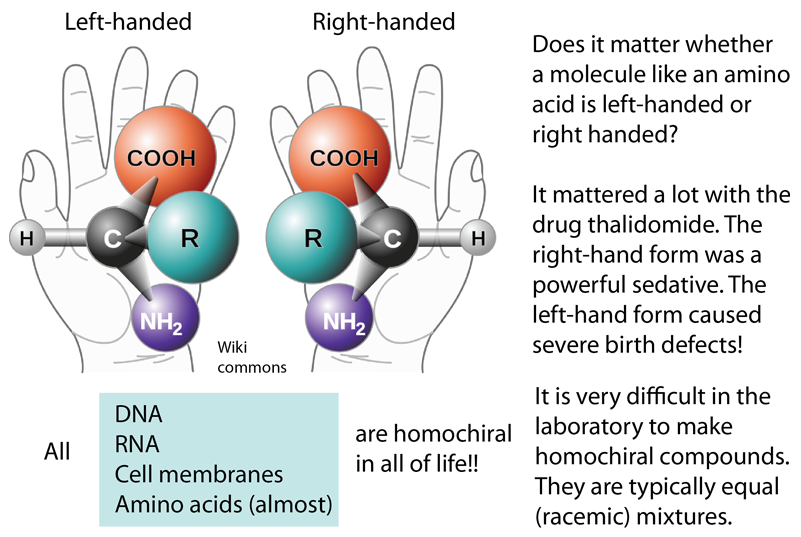
p87 Ch 8: Homochirality of Building Blocks
p87 Uses thalidomide to illustrate the disastrous effects of the wrong chirality in life processes.
p89 "DNA could therefore exist in a very wide variety of possible chiral configurations, but all life makes use of the exact same configuration. RNA also has the same chirality in every known form of life .." "Amino acids in living organisms are almost exclusively left-handed. Incorrect chirality in just one amino acid of a protein can interfere with function."
Cell membranes are also homochiral in all of life. The glycerol molecule of every phospholipid is exclusively left-handed in bacteria and eukaryotes. Unexplainably, the same glycerol molecule is exclusively right-handed in archaea."
p90 "Homochirality is so unique to living organisms, and so unnatural outside of living organisms, that tests of homochirality have been applied to amino acids of unknown sources to determine if they were formed by abiotic reactions ..." "In all living systems, homochirality is produced and maintained by enzymes, which are themselves composed of homochiral amino acids ... homochiral DNA, RNA, tRNA...
p90 "No one has ever found a plausible abiotic explanation for how life could have become exclusively homochiral. This is but a brief description of the homochirality paradox of life, a great challenge for all who support abiogenesis."
p91 19 of the 20 amino acids are chiral, glycine being the exception.
p92-93 Discusses techniques for obtaining some chiral excess, but not a solution to the paradox.
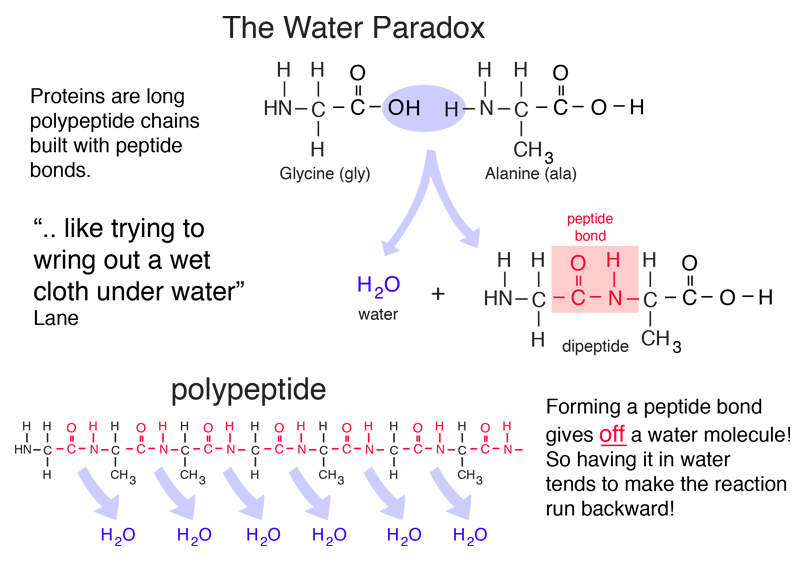
p95 Ch 9: A Solution for the Water Paradox
p95 "Organic synthesis is very hard to do in water. Highly oxygenated compounds are needed. The synthetic chemist must project the oxygenated groups out toward the water domain, and project the non-oxygenated groups in toward each other,thus generating a hydrophobic domain. It is very hard to do." James Tour
p96 "organic synthesis is highly constrained in water: water discourages the polymerization of nucleotides to make DNA or RNA; water discourages the polymerization of amino acids to make proteins; and water naturally degrade DNA, RNA, and proteins. This creates the 'paradox of water,' because water is both essential to life and detrimental to the start of life."
p96 "The polymerization reactions that produce DNA or RNA from nucleotides, as well as those that produce proteins from amino acids, each produce one molecule of water for each added monomer. Therefore, the presence of water as a solvent naturally drives these reactions in the wrong direction. Nick Lane describes this as 'a bit like trying to wring out a wet cloth under water.' In life, this polymerization reaction must be driven by a source of energy, just as your car needs a source of energy to move uphill."
p96 Interesting example of an experiment on production of proteins that required separate isolated steps with a cleansing in between - something that required foresight and intelligence and the ability to isolate - clearly not an abiotic senario!
p97 Review of what is necessary for formation of DNA in life, requiring energy from ATP which requires the energy production chain and finally ATPsynthase.
p97 Water corrodes DNA and RNA by deamination and depurination, which I don't understand, making it necessary to provide repair for the damage as a part of the life process.
p98 Recounts some of the fantastic proposals for overcoming the water paradox in an abiotic setting.
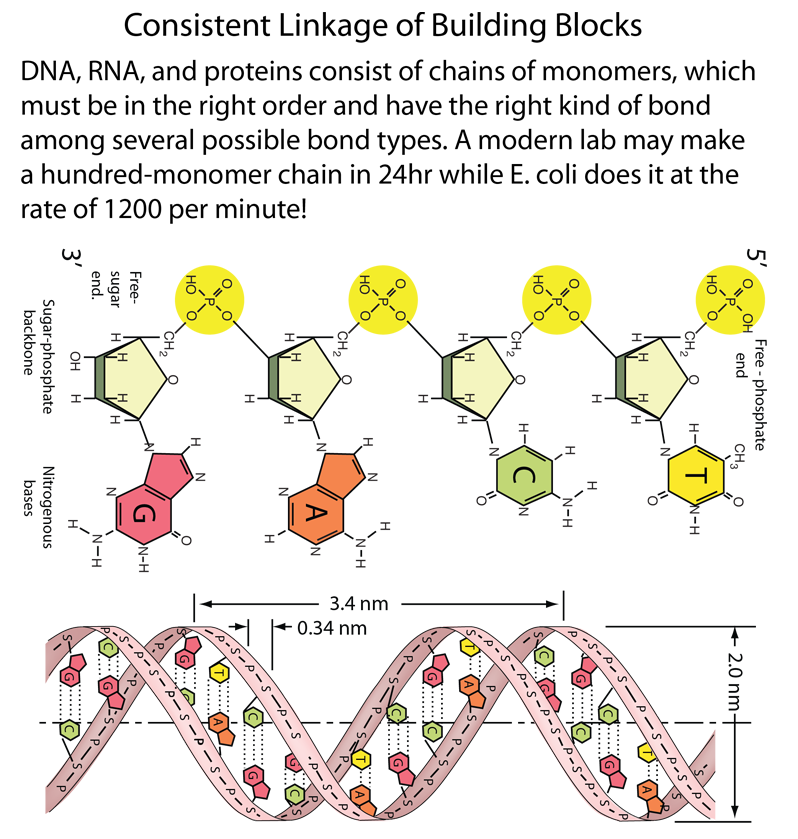
p99 Ch 10: Consistent Linkage of Building Blocks
p100 The next challenge is how to consistently link together long polymers with a specific content, given that the correct order is not constrained by an energy advantage. Refers back to the complex process in Ch 2 in Venter's synthesis process.
p100-103 Describes experiments which were partially successful in producing ordered sequences. Describes the monmorillionite clay experiments which gave the best percentage of success, but cites the problems. Decompose in presence of water. Describes Di Mauro's experiments with purified nucleotides and have reached 20 monomer length. But his commment: "As Benner noted, prebiotic chemistry without selection leads to tar formation." About 100 nucleotides under most favorable conditions, compared to a half-million nucleotides in the simplest known free-living organism's genome.
p103 In living organisms, amino acids join by alpha-peptide bonds, but there are several other ways for them to bond.
p104-5 Sidney Fox, pure amino acids, majority of bonds not the desired alpha-peptide bond.
p105 In modern lab, non-alpha linkages common and takes about a minute per linkage. In E.coli 1200 amino acids per minute with superior accuracy.
p105 "All empirical evidence tells us that homolinkage of DNA, RNA and proteins can only be achieved via the highly specific and catalytic activity of enzymes and ribozymes or via the careful planning of intelligent agents. In short, without the intervention of intelligent agents, existing biopolymers are required for the production of biopolymers."
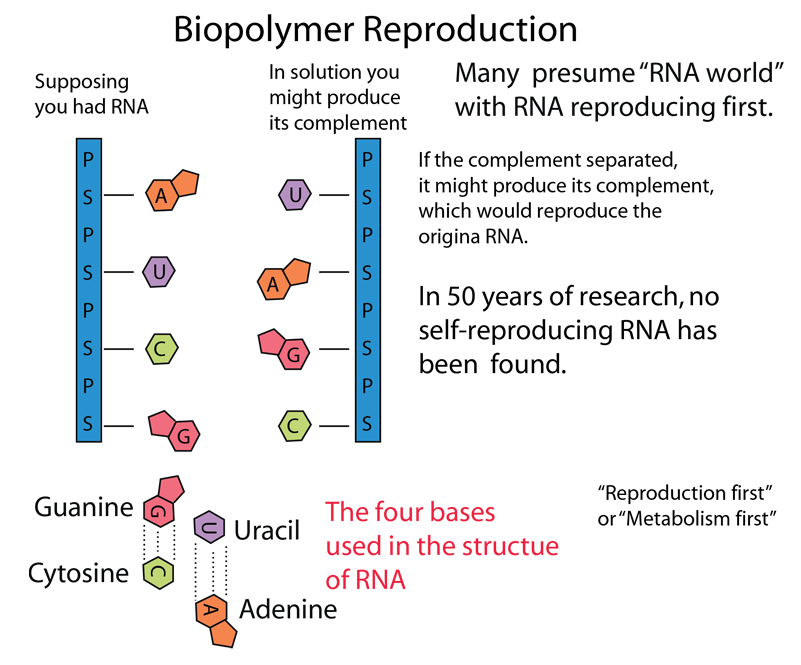
p107 Ch 11: Biopolymer Reproduction
p107 "If abiogenesis has any merit, reproduction must have occurred long before the arrival of the first living cell; reproduction must have started at the molecular level." Brief discussion of the "reproduction first" or "metabolism first" 'camps' among origin-of-life researchers.
p108 "reproduction of DNA is a very complex process, even the simplest prokaryotes require the coordination of at least fourteen enzymes (including 25 polypeptides) to reproduce DNA. It would seem that DNA is a poor candidate for the first reproduced molecule."
p108 Discusses the plausibility of RNA reproduction first, and surveys the "RNA World" hypothesis. Some history, with Altman and Cech providing "great encouragement .. by demonstrating that RNA can also have enzymatic properties in the form of ribozymes" (Nobel prize, 1989). "Ribozymes are now known to be a fundamental component of ribosomes, which are responsible for the synthesis of proteins from messenger RNA." "RNA was beginning to look like the 'jack-of-all-trades' molecule, a perfect candidate for the start of life. Leslie Orgel, a strong advocate for abiogenesis, wrote, 'The demonstration that ribosomal peptide synthesis is a ribozyme-catalyzed reaction makes it almost certain that there was once an RNA world.'"
p109-111 Story of "Spiegelman's Monster". RNA was reproduced outside a cell for a bacterial virus of size 4200 nucleotides, but it required supplying a protein enzyme Qbeta replicase which has four protein subunits and more than 1200 amino acids. He reported reproduction over 75 generations and an increase in repliction speed, but this was shown to be a devolution with 83% smaller size. "hardly a poster child" was part of their comment.
p113 50 years since Spiegelman's work, and relatively little progress.
p114 2018 research by Attwater, et al successful reproduction with combination of 135 and 153 unit segments.
p116 Authors remain skeptical about real RNA replication in abiotic environment.
p118 "decades of research have failed to provide a scenario for abiotic arrival of self-replicating molecules." If abiotic processes could yield self-replicating RNA molecules, "One should hardly be able to work with RNA without encountering yet another self-replicating RNA. Yet not one has been found in over fifty years of trying."
This is the most complicated chapter so far, a formidable mystery with capable people on both sides of the RNA world story.
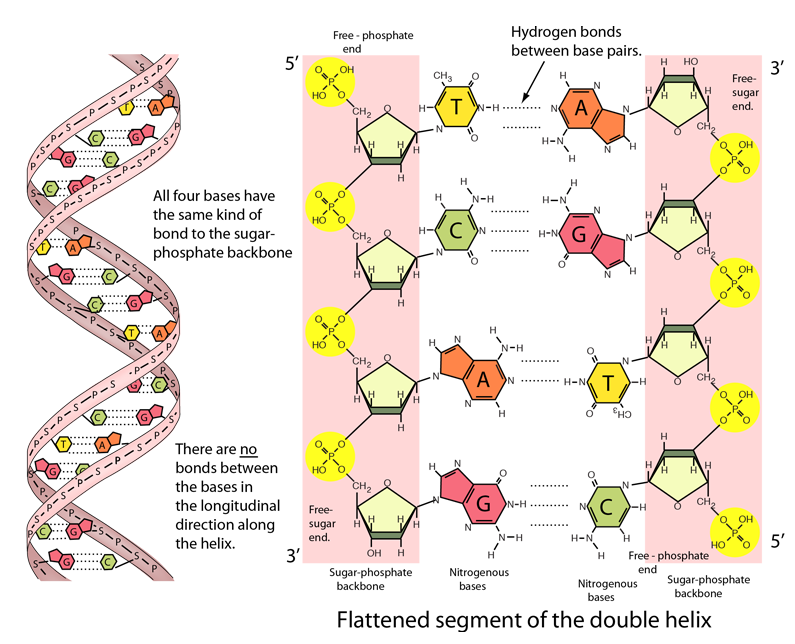
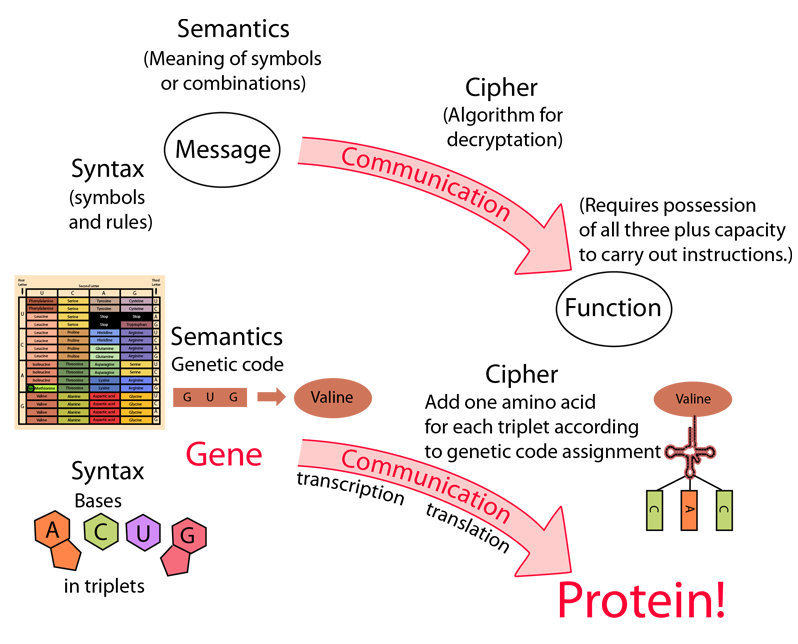
p121 Ch 12: Nucleotide Sequences Forming Useful Code
p121 "In DNA and RNA, no chemical or physical forces impose a preferred sequence or pattern upon the chain of nucleotides. In other words, each base can be followed or preceded by any other base without bias, just as the bits and bytes of information on a computer are free to represent any sequence without bias. This characteristic of DNA and RNA is critical - in fact, essential - for DNA and RNA to serve as unconstrained information carriers. However, this property also obscures any natural explanation for the information content of life - the molecules themselves provide no explanation for the highly specific sequence of nucleotides required for specific biological functions."
p122 Cites Doug Axe's research leading to infinitesimal probability for randomly achieving a specific protein. "The rational conclusion is that randomly arranged biopolymers offer no hope for the arrival of useful information or functional molecules."
p123 This chapter presumes success in all previous steps, so "two possibilities here: one self-replicating RNA that evolved multiple functions (multiple 'genes' in one RNA) or several RNA molecules that each evolved unique functions (multiple 'genes' spread among several RNAs, each capable of self-replication or of being replicated by another RNA). Reviews Spiegelman's devolving example.'
Review's Venter's simplest form. Synthia was about 1000 genes, simplest was 473 (513,000 base pairs). Discussed top-down approach, then returns to bottom-up.

p127 Ch 13: Means of Gene Regulation
p127-129 Discusses implications of unregulated genes, excess of production. Sensing, decision from sensed value, means of acting on information. Uses E. Coli and tryptophan control as example: produces enzyme tryptophan synthase to initiate production, amount of tryptophan causes negative feedback on production, codes for TrpR repressor protein to inhibit tryptophan synthase production.(p130 says TrpR composed of 107 amino acids that are encoded by 321 nucleotides of DNA/RNA). Example of multiple coordinated components.
p129 Brief discussion of how an RNA/ribozyme approach might accomplish as similar goal, but that like the TrpR above would need to be quite complex.
p130 Interesting discussion of a bacteria with a section of RNA added to a messenger RNA which codes for a metabolic enzyme. When that segment detects the product of the mRNA, it turns and cuts the mRNA to stop production. This one used as support of the RNA world hypothesis, but with no discussion of how it arrived.
p130-132 Description of restriction enzymes which provide difficulty for abiotic origin. This section is subtitled "Homeland security" because the restriction enzyme cuts and destroys foreign DNA. "Homeland" DNA has methylated points, produced by another enzyme. These then have to be created simultaneously or they would lead to cell death. Speaks of toxin-antitoxin pairs which are common and provide a challenge for abiotic origin.
p133 A small parasitic RNA could rapidly reproduce and hinder the production of useful ribozymes. Protection could be a ribozyme that destroys the small RNA, but it could destroy all RNAs that had a piece matching that offending small piece. So you have to have an agent that identifies and protects the vulnerable RNAs, and it would have to be acquired simultaneously with the destroyer. The requirement in this scenario is an additional layer of information content -- hard to see how you get it in the purely random, zero-foresight abiotic scenario.
p133 "Although we can readily observe this additional layer of regulatory information at work in all known life, we have no materialistic explanation for the arrival of this information. Materialistic explanations are especially strained in cases like restriction systems, which require the simultaneous arrival of multiple regulated components to produce a benefit rather than a detriment." This is the real punchline of this chapter.

p135 Ch 14: Means for Repairing Biopolymers
p135 "The current abiogenesis story ascribes millions of years, perhaps hundreds of millions of years,for the accumulation of this information." "deep time as the protagonist in the drama .." "Unbeknownst to the playwright, their hero has a dark side: time is a subversive agent intent on destroying - not accumulating - information."
p136 Attacks on human DNA daily:
- 2,000-10,000 depurinations
- 600 depyirimidinations
- 10,000 cases of oxidative damage
- 55,000 single strand breaks
- 10 double strand breaks
- List 8 different specialized DNA repair mechanisms, each requiring enzymes, up to five of them.
138 During reproduction of DNA, bacteria have three types of DNA polymerase, all capable of detecting an incorrect base pairing and backing up one step to excise the error, then progressing (called proofreading). Decreases error rate from one in 100,000 to one in 10,000,000 base pairs.
p138 Conundrum: "DNA repair mechanisms could not have evolved without the protection of DNA repair mechanisms. And ordinary DNA could not have evolved before DNA repair genes evolved."
p138 We can't really say what the RNA world equivalents would be, but they note that repair would certainly be needed because RNA is more vulnerable to damage on several fronts.
p139 Eigen's paradox. RNA would need some errors to have an opening to develop into different forms with time, but the error correcting mechanisms would need to be programmed into the RNA.
p140 "What we need for abiogenesis is a self-replicating RNA that has just the right error rate during reproduction, resulting in an information gain over millions of years ...and the preservation of information via repair mechanisms that spontaneously appear." "What we have is the absence of a self-replicating molecule, evidence that replication processes prefer shortening and simplification of RNA over time, and no hope of arriving at the required repair mechanisms."
p140 Also points to fact that organic molecules decay rapidly at the end of life, decreasing the plausibility of steps toward complexity and organization in the abiotic world.

p141 Ch 15: Selectively Permeable Membranes
p141-142 Phospholipids can spontaneously form vesicles of bilayers. "But no living organism could survive with such a simple cell membrane."
p142 "single phospholipid bilayer ..can rapidly transition to a multilamellar structure.." "Living organisms can actively modify the phospholipid composition of their membranes in response to temperature changes to maintain stability of their single-bilayer membranes .."
p142 Discusses the critical nature of the proton gradient - membranes must be tight enough to block the free passage of protons, yet must facilitate passage of larger structures in for needed materials and out for waste. x
p143 "..specialized pores in the membrane that are composed of proteins. In fact, proteins account for approximately half of the mass of cell membranes in prokaryotes, and even the simplest known autonomously reproducing cell, Mycoplasma genitalium, operates with about 140 different proteins integrated into its membrane. Of all the known proteins produced by living organisms, approximately one-third operate within membranes."
p143 One of the things I have had reinforced by this book is the critical importance of the proton gradient. They get pretty dramatic - if you lost the proton gradient, you would be inoperative within a few seconds and dead within minutes - compares to cyanide poisoning. "A nonspecific membrane pore that is always open would destroy the proton gradient. Therefore pores must be highly specific, and most pores open only when triggered to open." Fascinating description of aquaporins, the specialized pores that conduct more water molecules into the cell than diffusion provides, but by precise manipulation of individual water molecules in a way that lets them in but does not permit protons to sneak in with them.
p144-146 Since pores typically transport molecules against a concentration gradient, they require energy. Uses example of challenge of transporting "ATP-binding cassette(ABC)" with which I am not familiar. But one point is that inserting the transporter into the membrane is very challenging since it must have hydrophilic ends and hydrophobic center, so how do you persuade it to go into the membrane in the first place? Used ATP in stages to open and close the pore in stages to transport a protein structure in stages without disturbing the proton concentration.
p146 More discussion of how you insert a pore into the membrane. The process is described as the "general secretion pathway" and requires DNA, RNA, ribosomes, ATP(or GTP) and other proteins. It is so complex as to provide an argument against abiogenesis. Further discussion here that I should study more.
p147 Insertion of a protein into a membrane requires proteins that are already in the membrane, generating a "chicken or egg first" dilemma. "The plans for the membrane-bound proteins are encoded in the cell's DNA. ..it does not specify the localization and the organization of those molecules in the cell membrane. ... achieved through inheritance of the progenitor cell's membrane" "No cell has ever been observed to generate a complete de novo functional membrane." "Membranes are inherited and used as a template for expansion; they are not fabricated from scratch." Franklin Harold: "Just as every cell comes from a cell, so does every membrane come from a membrane."
p 148 They end this chapter with one of their strong statements of skepticism about abiogenesis: "There is no evidence that simplified proto-membranes could meet the requirements for starting life or could complexify over time to successively approximate the complex membranes we observe today. Just as cells only come from cells, membranes only come from membranes."


The marvelously crafted devices in the cell membrane transport electrons, produce a proton gradient, and drive a nano-machine to make the basic fuel molecule ATP.
p149 Ch 16: Means of Harnessing Energy
p149 "..the activities of a living organism require a continuous source of energy. Life is simply not possible without energy. A fundamental characteristic of life is organization - layers upon layers of organized complexity. Such organization naturally opposes the second law of thermodynamics, which states that net disorder must increase over time in a closed system. Opposing the second law of thermodynamics requires continuous and specific application of energy."
p150 Describes the energy transport and supply process as "chemiosmotic coupling", but I prefer the more usual approach of describing the energy chain in terms of glycolysis, the TCA cycle and the electron transport chain ending in ATP production. They get to that, and have the interesting note that the human body contains only about 60 grams of ATP at any given moment, but regenerates approximately their own weight in molecules of ATP every day.
p151-155 Good description of the electron transport chain.
p155-158 Good description of the ATP synthase and ATP production. Notes that John Walker got Nobel Prize in 1997 for describing the structure of ATP synthase. Also note that the process in the simplest forms of life "requires a minimum of forty-five complex, interdependent protein molecules", and that neglects the ribosomal and transcription proteins needed to produce those proteins.
p150 "Thus, a prebiotic means to arrive at the requisite energy harnessing of life remains an enigma."


p161 Ch 17: Interdependency of DNA, RNA, and Proteins
p161 As a pathway for developing the text, the authors have taken the "RNA world" presumptions and the development of life processes with RNA as both information storage and catalysis of production of the necessary molecules. But at some point they have to jump off that ship and talk about the observed world with DNA in that primary information storage site. So about the primary role of RNA they come to "This is an imaginary scenario for life because no known life today can operate exclusively on ribozymes."
p162 Emphasizes the separate functions of RNA and functioning proteins that accomplish the tasks in the cell. They are separated by a code. "not a single mRNA behaves like its corresponding protein."
p163 Referring to the "central dogma of molecular biology", they "jump ship" on the primary role of RNA and start over with "different information combined with the arrival of new molecular machinery for processing the information." This new organization and cast of characters is frequently called the "Central Dogma" of molecular biology based on DNA as the information repository.
p163 "Reproduction of DNA, even in the simplest prokaryotes, requires the coordinated efforts of at least fourteen enzymes (incluing 25 polypeptides) and RNA to act as primers. "
p164 Uses E. coli reproduction as example, discusses the complicated enzyme topoiseomerase IV which is essential for completing reproduction.This fact is used in the antibiotic ciprofloxicin which disables it to kill the bacteria.
p165 They get down to a hard-nosed punchline: "The hypothesis that RNA molecules accumulated information toward a first living organism is a dead end because life as we know it today is based on entirely different information." Gets down to the "chicken and egg" dilemma: "However, DNA cannot be replicated without these proteins, the replication proteins cannot be produced without the DNA, and evolution cannot occur without replication. Thus, we have yet another series of impossible interdependencies for abiogenesis."
p165-167 Continue with the story of "Layers of Impossible Dependencies". Discusses the multiple proteins involved, the genetic code, the variations in the genetic code, the development of translation of the code, and the mystery of the complex interdependencies of DNA, RNA and proteins.
p168 "Because DNA, RNA and proteins are interdependent, they must all have appeared simultaneously to contribute to a living organism. The simultaneous arrival of such complex biopolymers with highly specific required interactions between the biopolymers presents quite a challenge for abiogenesis."
p168-169 Illustrations to help visualize the relative sizes of DNA and E. coli. If E. coli the size of your car, the DNA would be about 2.2miles long. More reflections on length, packing of DNA and the molecular tools needed to do it.
p170 Electron micrograph of spread-out E. coli DNA.

p171 Ch 18: Coordinated Cellular Purpose
p171 Story of a shovel insertion producing a "near-Armageddon" for a colony of ants, yet their purposeful and coordinated effort is applied to the rebuilding process. "The coordinated activity and the high-level organization follow from a tangible, inborn purpose."
p172-175 Describes having all the required chemistry and protein structures thrown together in a "bacteria in a blender" scenario, and reflecting on the building and disassembly process working at the same time, so that despite the resources, no life can be built - chaos and decay, no life! Back to "every cell comes from a previous cell"(Rudolph Virchow).
p177 Ch 19: The View from the Top of the Stairway
p183 Part III. Conflict Resolution
p185 Ch 20: Why Do People Believe in Abiogenesis?
p193 Ch 21: Supplanting Abiogenesis
p201 "The only known source for this type of information is intelligence. Living organisms and the Stairway to Life are powerful evidence of God - an inescapable conclusion when one if free to follow the evidence where it leads."
p203 Epilogue
p213Anticipated Objections
| Windows of Creation |
| Evidence from nature | Is the universe designed? |